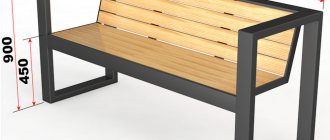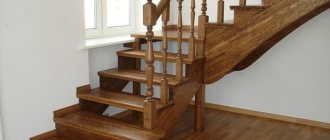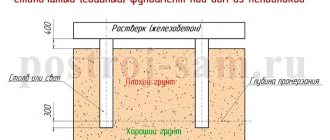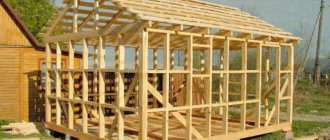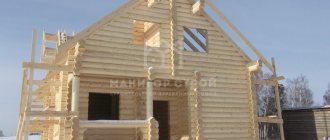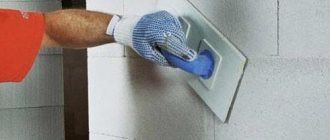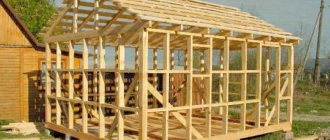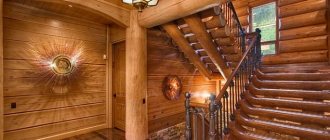Types of chicken coops
The easiest time to raise poultry is in the summer, when it is warm and there is plenty of green grass. In winter, the issue of keeping chickens needs to be taken more seriously, since in extreme cold the chicken will freeze, lay poorly and may even die.
Mobile
In the warm season, you can use a lightweight portable chicken coop for 10-20 chickens. It is a small frame structure, in one part of which there is a house with perches and nests, and the other is covered with a net for walking. A mobile chicken coop is first installed in one place on the site, and after the birds eat the grass, it is moved to another. By the way, you can make a mobile rabbitry with your own hands; we have already written about this.
Stationary
From the point of view of comfort for the bird, this option is the best. The chicken can take refuge in it from cold, wind and dampness. It is used for breeding livestock throughout the year.
Stationary chicken coop option
In stationary chicken coops, both floor rearing and keeping chickens in multi-tiered cages are used. In the latter case, the poultry is compacted, which saves space, but more careful care and regular disinfection are required.
Preparation for construction
We calculate the sizes
To build a pen for chickens with your own hands and the optimal size, you should determine the number of chickens. The standard size of a chicken coop is 2x7 meters for 10 chickens. Or 1 sq. m for 2 birds.
A larger area can be allocated for chickens if the area of the plot allows. They love space. There are breeds of chickens that can get sick more often if space is cramped. Other breeds fight among themselves. Egg-laying birds lay eggs worse.
Choosing a place
If a stationary structure is planned, the choice of location should be taken responsibly.
Stationary pens must have a solid wall on the north side. Ideally, such a wall is a chicken coop.
The article “Construction of a chicken coop with a range for 100 laying hens” will tell you how to do it correctly.
If the chicken coop does not allow the enclosure to be located on the south side, then the pen is built close to any of the walls. And its northern side is made of corrugated board or slate.
If a place is chosen for both a pen and a chicken coop, you can rationally use the territory. Namely, by making the chicken coop hanging, and walking under the chicken coop.
The walking area should be dry and windless. With shade from the sun. And on a small hill so that when it rains, the area of the enclosure will not be flooded.
Requirements for conditions of detention
Sanitary and veterinary standards are developed taking into account the maintenance of favorable conditions for poultry and are aimed at preventing the spread of infectious diseases. They contain requirements for the placement of chicken coops in summer cottages and garden plots, as well as for general conditions of maintenance:
- the development site must have a drain for surface water;
- retreat at least 4 m from the boundary, 12 m from the house - a neighbor’s or your own, 7 m from the entrance to the house if the structure is attached;
- each type of bird must be provided with a separate room and run;
- observe the lighting, ventilation and heating regime in the chicken coop;
- regularly carry out thorough cleaning and disinfection (at least 2 times a year).
If sanitary requirements are grossly violated, not only will the health of your chickens be at risk, but it will also be unsafe for surrounding farms.
What to consider during construction
Wall material
The chicken coop requires periodic disinfection of the walls and floor. Therefore, it is necessary to carefully select the material for the walls.
Previously, only materials common in the area were used for auxiliary objects.
Today there is no such problem. You can build a chicken coop with your own hands from any convenient material.
For the manufacture of permanent buildings, you can use wood, brick, and foam blocks. A chicken coop for year-round raising of chickens needs a foundation and high-quality wall insulation.
Wooden chicken coops are popular. They are easy to maintain, warm in winter and cool in summer. However, chicken droppings will eat away at the wood surface over time. To protect against moisture and mold, wood requires periodic treatment with antiseptic agents.
A lightweight summer chicken coop can be built from plywood, edged boards, chipboard, OSB boards, and polycarbonate.
Which floor to make
If you keep chickens in a chicken coop all year round, you will need to install a heated floor. For this, several options are used: jellied, clay, earthen, wooden.
Wooden flooring is most suitable. It is warm, easy to clean and disinfect. In addition, the service life of a wooden floor is longer than that of analogues made of clay or earth.
Concrete floors are strong and durable. But it is cold and requires thorough insulation.
Details in the article “What is the best material for making floors in a chicken coop?”
Summer keeping of birds is also possible on mesh floors. They make cleaning the room much easier. Prevents contact of birds with droppings and the development of many diseases.
Manhole arrangement
When planning a chicken coop, it is necessary to think over a convenient passage for chickens, allowing them to move freely from the walking area to the chicken coop.
The manhole is placed at a height of no more than 10 cm from the floor level. Average dimensions - no less than 40 by 40 cm.
The hole is covered with a thick door, protecting the room from the cold in winter. And at night - from predators.
Additional wall insulation
Thin load-bearing walls of a permanent chicken coop require insulation and finishing. To do this, install the frame and lay insulation. The top can be covered with any decorative material.
Polystyrene foam, mineral wool and even sawdust are used as thermal insulation materials.
For interior wall decoration, plywood, board or other material that is at hand is suitable.
Windows and doors also require high-quality insulation. Eliminating drafts and cracks will help retain heat inside the room for a long time.
Find out how to properly retain heat in the article “How to insulate a chicken coop for the winter with your own hands.”
Now let's figure out how to equip a barn for chickens according to all the rules.
Walks and capacity
At poultry farms, birds are kept in cages, since it is impossible to arrange a full range of animals. This is not the most natural way to live. Walking is especially important for laying hens. The opportunity to sunbathe and diversify the diet with beetles, worms and roots has a beneficial effect on egg production and egg quality.
It is easier to organize walking in a homestead environment than at a poultry farm. You can release the bird into a fenced part of the yard, garden, or even outside. Walking is not required for broilers. These are early maturing hybrids that eat most of the time and move very little. They are mainly kept in cages or in a poultry house on deep litter without walking.
The capacity of the chicken coop depends on what type of poultry breeding you are going to do - egg, meat or meat-egg. Thus, the recommended standards prescribe the following stocking density per 1 head:
- 0.25 m² for laying hens;
- 0.125 m² for meat breeds;
- 0.2 m² for meat and eggs;
- 0.08-0.09 m² for young animals up to 9 months old.
With a simple calculation, the minimum area of the room for 10-20 chickens is:
- for laying hens - 2.5-5 m²,
- for broilers - 1.25-2.5 m²,
- for universal ones - 2-4 m².
Reducing the area is not recommended. This leads to great overcrowding, and as a consequence, deterioration of the microclimate and conditions for keeping poultry.
Should you buy an inexpensive chicken coop?
Today it is less and less common to build something with your own hands. It is much easier to buy a ready-made mini-chicken coop and not have to figure out how to build one yourself. In some cases this decision is justified. If you do not have experience in the construction of farm buildings, you are unconfident in your abilities or do not have enough time, it is better to buy a good chicken coop and provide the chickens with comfortable living conditions.
In addition, it is appropriate to buy a chicken coop if your plans include commercial chicken breeding and you need a large-scale poultry house for a hundred chickens. Or, on the contrary, if you need a very small chicken coop and do not plan to breed birds.
However, building a poultry house yourself will cost less, and you will be able to equip it entirely in accordance with your own desires and ideas about the ideal chicken coop. After watching the video on how to properly build chicken coops with your own hands, you can easily expand and complete the poultry house in the future if necessary.
Today, there are many drawings and videos of building a chicken coop with your own hands available on the Internet that will help you understand and master this skill yourself.
Safety for chickens
In the poultry house and on the run, poultry faces many dangers:
- infectious diseases;
- external enemies - foxes, stray dogs, ferrets, hawks and other predators;
- small rodents.
Only feeling protected, the bird is calm, eats food well, gains weight and rushes.
To create a safe environment for the bird, you must:
- comply with capacity standards;
- regularly disinfect the premises;
- do not let in strangers who could become a source of infection;
- protect yourself from rodents and predators.
If everything is clear with the first three points, then how to get rid of mice and rats? They can cause a lot of harm, since the risk of infection with various diseases is extremely high. In addition, pests eat food intended for chickens, steal eggs and choke small chickens.
Rodents love to settle in insulation on the roof or in the walls, so polystyrene foam, polystyrene foam or mineral wool should be wrapped in a metal mesh with a mesh size of no more than 5-8 mm. To prevent rats from chewing their way through the floors, place a layer of broken glass mixed with crushed stone or gravel in the trench around the perimeter of the house.
An effective folk remedy for mice and rats is wood ash. It needs to be mixed with bedding in the proportion of 1 bucket per 4 sq.m. area and distribute evenly over the surface with a rake.
Traps work well in places where rodents move, but they need to be placed outside the boundaries of the chicken’s habitat. Pests can only be poisoned outside the chicken coop, so that the birds do not peck at the poisonous bait. Carrying out a set of these measures will ensure peace of mind for you and the entire bird flock.
Trap for rodents
A special device called an “electric shepherd” will help protect you from foxes, ferrets and other misfortunes. This mesh structure is fixed to poles around the paddock. The equipment can operate from the mains or independently from batteries, a built-in battery with a solar energy generator.
In operating mode, when you touch the fence, a small voltage discharge occurs, which is safe for birds or animals, but effectively scares away anyone who wants to profit from fresh chicken. An electric shepherd is not cheap, but no other additional fencing is required, and the bird will be safe.
Chicken nutrition at different times of the year
The diet of laying hens is adjusted depending on the time of year. Thanks to seasonal feeding, poultry farmers achieve increased poultry productivity. Depending on the time of year, poultry farmers change feeding norms - An approximate diet and norms are given in Table 3.
Table 3
| Feed, g | Winter | Spring | Summer | Autumn |
| Greenery | 20 | 30 | 20 | |
| Herbal meal | 5 | 3 | 3 | |
| Gravel | 1 | 1 | 1 | 1 |
| Yeast | 3 | 4 | 3 | 3 |
| Cake/meal | 12 | 13 | 12 | 12 |
| Crushed grain | 50 | 55 | 60 | 55 |
| Whole grain | 50 | 45 | 40 | 45 |
| Bone flour | 1 | 1,5 | 1,5 | 1 |
| Carrot | 40 | 20 | 20 | |
| Meat and bone meal | 5 | 7 | 5 | 5 |
| Return | 20 | 30 | 30 | 20 |
| Salt | 0,7 | 0,7 | 0,7 | 0,5 |
| Wheat bran | 10 | 1 | 10 | 10 |
| Shell, chalk | 4 | 5 | 4 | 4 |
Winter
In winter, chickens are fed 3-4 times a day. Preference is given to mixed feed. The diet must include boiled vegetables and cake. Give the mash warm so that it doesn’t get cold. Add fish oil. Greens are given in dried form - they are stored in the summer. The hay is hung at a height of 30 cm.
In winter, feed is given 15-20% more than usual - 160-180 g. Approximate “winter” menu:
- for breakfast – soaked mixed feed with herbs;
- for lunch - wet mash;
- for dinner - whole dry grain with the addition of a premix.
Maintain the ratio:
- carbohydrates – 50%;
- plant foods – 20%;
- proteins – 30%.
You can increase the amount of boiled potatoes, give yogurt and cottage cheese more often, and it is recommended to replace the water in the porridge with fish broth. In winter, sprouted grain, gravel and wood ash are also recommended. The drinking bowls contain clean warm water.
Summer
In summer, laying hens are not fed as abundantly as in winter. The number of feedings is 3. The composition and norms of nutrition change. The diet should include:
- protein – 50%;
- carbohydrates – 30%;
- other feed – 20%.
The bird leans on fresh grass, receiving vitamins. She gets additional protein from bugs and worms. Feeding – 120-150 g:
- morning - wet mash;
- during the day – dry food or feeding on a walk;
- dinner - grain mixture.
Spring
Spring feeding is similar to summer feeding. In the spring-summer period, egg production reaches its maximum. It is in the spring that productivity begins to increase, which means you should diversify your diet as much as possible. The number of feedings is 3. Moreover, one meal can replace a walk in the yard - here the bird will find grass, beetles, worms, and midges. Nutritional norm – 120-150 g.
Autumn
In the fall, chickens molt and change their plumage. Their body is weakened, and their metabolism deteriorates. During this period, chickens are fed 3-4 times a day. Molting lasts about two months
It is important to provide the bird with food. Recommended dietary allowance is 130-150 g:
- increase the protein content of feed;
- give more animal feed - meat waste and earthworms;
- add vitamins to the feed mixture;
- give more succulent food - grass, vegetables, tops, root vegetables.
The autumn diet should include:
- skim milk and cottage cheese;
- eggshells;
- shell rock and chalk;
- beet tops;
- green legumes;
- carrots, boiled potatoes.
The bird is fed:
- morning - a third of the daily grain intake;
- lunch - wet mash with vitamins and minerals;
- dinner - grain.
Dimensions and drawings of the chicken coop
When developing your construction plan, you need to draw up a drawing taking into account the behavior of the chicken:
- At night, birds sleep on perches - horizontal bars raised 60-90 cm above the floor. One head requires from 17 to 25 cm of its length, for a chicken - 15 cm. The perches should not be located one above the other so that the chickens sitting on top do not stain those below with droppings. The distance between the crossbars is from 30-35 cm.
- The second thing you need to provide is comfortable nests. It is not necessary to make them for each member of the herd; 1 seat for 3 laying hens is enough. The optimal nest size is 35x35-40x40 cm.
- The walking area is not standardized. It is determined by the capabilities of your site. If the chickens will be kept without an aviary, you can install an ash bath in the barn at the rate of 0.12 m² per head.
Let's look at a finished drawing of a chicken coop for 10 chickens. This poultry house is very compact, but roomy. The dimensions of the house are 88x95 cm, at the ridge 110 cm. For convenience, nests with a lid are built into the side, which must be opened to collect eggs. In the front wall of the house there is a folding bridge or door for the bird to exit into the enclosure. You can build perches inside another wall.
The paddock is surrounded by a net on all sides. Its dimensions are 98x95 cm. You can enter through a small mesh door. Feeding and watering are provided directly in the enclosure. For periodic maintenance of the house, you can make the roof folding.
Here is a drawing of a barn for 20 chickens. The dimensions of the chicken coop are 150x300 cm. Nests and perches are installed inside. For walking, there is a fenced area of 375x200 cm, where the bird will leave the house through a separate passage. There is a vestibule attached to the barn, where it is convenient to store feed. The walls of the structure are panel walls with insulation, their thickness is 25 cm.
Sanitary standards for keeping chickens in private household plots
Permitted quantity
Law of the Russian Federation No. 112 “On personal subsidiary farming” does not limit the number of livestock. The main thing is to comply with sanitary conditions when organizing the life of chickens.
But restrictions may be imposed by regional legislation. And the head of the settlement in which the farmer lives.
Several years ago there was talk of amendments to the law on private household plots. If deputies nevertheless accept them, the permissible keeping of birds in one area will be strictly regulated.
Stocking density of young animals
Now about how many chickens per 1 sq. meter can be kept in a personal plot. Stocking density depends on the type of bird. And the method of keeping: bedding or mesh floor, free range or cage.
When keeping hatched chicks in a brooder, a maximum of 25 birds per 1 square meter is allowed. meter
When the babies turn one month old, their number per square meter should decrease to 16 heads. After two months - up to 9 goals.
Adult stocking density
For 1 sq. meter keep 5-6 adult hens of egg breeds. And about 6-8 representatives of the meat department.
If the chicken coop contains birds of the parent flock, then per 1 sq. meter of mesh floor the number of heads should be about 3-4 heads. When using deep litter, the density of livestock is reduced to 2-3 chickens.
If cages are used, hen stocking densities vary from 4 to 10 hens per square meter. Depending on their size and weight. Broilers are seated more densely - 10-12 heads.
Why do you need to follow the rules?
Raising chickens in the village and other private household plots requires the farmer to impeccably comply with sanitary standards.
If these requirements are ignored, chickens can contract serious diseases that are dangerous to humans. As a result, the outbreak of an epidemic in the chicken coop will lead to massive infection of the residents of the settlement.
Requirements for chicken coops
Chickens can be kept in a barn. Or build them a chicken coop. But regardless of the premises used, the requirements for it must be observed.
So, the chicken house should not be tilted. Otherwise, rainwater will constantly flood the room.
A fence is erected on the territory of the farmstead so that the chickens cannot escape to the neighbors. But wild birds did not come to the chickens. Walking areas are also fenced. Chickens should go for a walk separately from other farm birds living on the farm.
Requirements for floors in the chicken coop:
- strength;
- low thermal conductivity;
- tolerance to exposure to disinfectants.
A door to the courtyard must be made in the room. Ventilation (natural or supply and exhaust) is arranged to maintain the required microclimate parameters.
Sanitary measures
The chicken coop should always be clean. Once every 1.5-2 months, a thorough disinfection of the entire room is carried out. Including walls and equipment.
To prevent the farmer from bringing infection on the soles of his shoes, disinfection ditches with disinfectant preparations are installed before entering the chicken coop.
When changing livestock, the bedding is completely replaced. And the floor is washed and disinfected. The thickness of the litter should be about 15 cm. It is unacceptable to use spoiled, dirty sawdust or moldy straw.
Before moving in new chickens, the walls and ceiling need to be whitewashed.
Litter must be removed regularly. When there is a large accumulation of excrement, ammonia fumes are released. Therefore, severe poisoning of chickens is possible.
Feeding and watering front
Another important parameter is the length of the feeder and drinkers. It depends on the number of livestock. One adult bird needs at least 6 cm, and young birds need 4 cm. If there is less space, it will be inconvenient for chickens to peck grains.
Each hen also needs about 3 cm of space at the drinker.
Microclimate
It is important to maintain a favorable microclimate in the chicken coop. Otherwise, the birds will start to get sick and stop laying eggs.
Humidity is set within 65-70%.
The optimal temperature is 15-18 degrees Celsius.
Where is the batch of hatched young animals placed?
Chickens are hatched in an incubator. Or they lay eggs under the hen.
The hatched young are placed in a brooder. This is a spacious box, pre-disinfected and warmed up.
Prevention and elimination of infectious diseases of birds
An outbreak in one bird can cause an epidemic in the chicken coop. To prevent such a situation, veterinary and sanitary measures are applied.
The farmer is obliged, at the first request of the veterinary supervision, to report the number of livestock living on the farmstead. If you suspect a disease, you must call a veterinarian so that he can make an accurate diagnosis and issue treatment instructions.
A sick chicken is immediately moved to another room and treated. In the absence of positive dynamics, slaughter or disposal is carried out. You cannot keep such birds on the farm.
Preventive feeding of the rest of the herd with medications is carried out.
If an epidemic occurs, a quarantine is imposed on the farm. The import and export of products and livestock is prohibited until the quarantine is lifted.
All chickens must be vaccinated. The procedure must be carried out by a veterinarian.
Is it permissible for chickens to live together with other animals?
Chickens can be kept in the same farmstead with other farm birds. But they need a separate room, equipped to suit their needs.
Detailed information is contained in the article “Keeping chickens with other animals in the same room.”
For high productivity, these birds require complete rest and certain climatic parameters. If a farmer raises chickens and geese in the same barn, their egg production will be lower.
Now let's talk about taxes paid.
Tax on chicken coop in private household plots
Today, legislation does not establish the payment of tax on keeping chickens.
But deputies are considering amendments to the law on private household plots. If they are approved by the State Duma, farmers will pay a tax on the sale of chicken meat and eggs.
Is it possible to raise chickens in a barn in private housing construction?
Individual housing construction (IHC) means a house with a height of no more than three floors for one family.
It is allowed to erect a vegetable garden and build sheds on the adjacent land plot. But to raise chickens, a private household plot category is required. Chickens cannot be raised in a private home.
Nests and roost
Let us dwell in detail on how and from what nests and perches can be made. Some chicken keepers construct small boxes from OSB, chipboard, furniture panels or plywood with a hole for the chicken to enter. In this case, the eggs can be collected through the hinged lid or the back wall.
Plastic boxes, thick cardboard boxes, used buckets or water cans are also suitable for making nests. They are fixed at a small height above the floor, straw, shavings, and sawdust are placed inside.
Remote sockets
Perches are constructed from wooden blocks with a cross-section of 4x6-5x7 cm. Sometimes they are made in the form of steps, where each chicken has its own place. The bird can fly up to a height of 60-90 cm on its own. If the perch is higher, you need to install a ladder. In order not to contaminate the litter once again, you can place a tray underneath for litter and regularly take it out to the compost heap.
How does egg fertilization occur?
The egg matures in the chicken ovary. Its active growth begins immediately before laying eggs. During this period, the follicle (shell) of the egg intensively produces the yolk substance. The ovary of a frequently laying female can simultaneously contain up to 4-6 large yolks. After the egg matures, the follicles are destroyed and the process of ovulation begins, during which the yolk is sent into the funnel of the chicken oviduct.
An experiment that was carried out in 1948 helped to find out in which part of the oviduct a chicken egg is fertilized. According to his results, the egg is fertilized 20 minutes after it is released into the upper part of the oviduct.
Cock semen and chicken eggs are found in the genital tract. After the seed enters the cloaca, it penetrates the egg membrane. At the same time, 20-60 germ cells enter the egg, but only one performs fertilization.
The rooster seminal fluid gets inside the egg because the calcareous shell (shell) has not yet been formed at this point. The hard shell is formed only a day after the fertilization process.
Heating and ventilation
To maintain a favorable microclimate in the chicken coop, it is necessary to provide air heating in winter and cooling in summer. The recommended minimum room temperature is +15°C, the maximum is +27°C. This does not mean that the bird will die immediately, but it will feel uncomfortable, which will immediately affect egg production.
Filling with sawdust will help maintain optimal temperature in the poultry house.
To heat the chicken coop use:
- potbelly stoves;
- electric radiators;
- infrared emitters;
- deep permanent litter.
The most economical way is a bedding at least 10-15 cm thick made of sawdust, crushed leaves, sunflower husks, etc. With the gradual decomposition of organic matter, heat is released, which warms the air in the barn to comfortable levels.
The air in rooms where chickens are kept contains a lot of ammonia. Natural ventilation is carried out by installing supply and exhaust ducts and ventilation. If this is not enough, use a mechanical drive system. The elements of the system are fans, electric hoods and other equipment.
How to build?
The construction of an aviary for chickens takes place in 2 stages.
Preparatory work
Particular attention should be paid to preparation for construction.
Selection of materials
The choice of means for creating a structure largely depends on its type:
- Mobile. Light materials are needed. Wooden beams measuring 50 by 50 mm are suitable. You can use PVC pipes, but they will cost more.
- Stationary. The main thing is to take care of the strength and long service life of the building. Therefore, it is better to use metal pipes and corners. Wood needs special treatment to protect it from rotting.
The main design element is the mesh.
The following requirements apply to it:
- Material. Mostly metal. Birds can become entangled in fabric mesh, which can lead to injury.
- Small holes. Their diagonal size should be no more than 2 cm, otherwise rodents can easily enter the enclosure.
A total of 5 types of mesh are used:
- Wire. Often used, but not reliable enough. Due to its low strength, the mesh is easily chewed by predators. And through large enough holes, chickens can escape. But it is a good option for creating the top cover of a pen, which protects chickens from birds of prey.
- Reinforcement. Very strong mesh that provides good protection. But at the same time, it has high rigidity and is difficult to work with. The cost is also slightly higher.
- Galvanized. The mesh has small cells, it is strong and reliable. No special treatment is required as the mesh is coated with oxidation protection. It is easy to work with and install. The most optimal option.
- Polymer. A good and inexpensive option. But if the area is susceptible to attack by rodents, they will easily gnaw it.
- Chainlink. Durable mesh that will last for many years. The disadvantage is that the cells are too large.
Also, to build an open pen you will need:
- hammer;
- Bulgarian;
- roulette;
- wire cutters;
- wire;
- hand drill;
- building level;
- concrete solution.
For an enclosure with a canopy:
- wire;
- bolts and nuts;
- polycarbonate;
- welding machine;
- drill;
- thermal washers.
Area calculation
When making calculations, you need to take into account that ideally one chicken requires 2 square meters. m. That is, the best option would be to build a stationary pen with an area of 20 square meters. m. for 10 birds. A mobile pen is usually built smaller, but it should still be taken into account that 1 bird will need at least 1 square meter. m.
Often you have to focus on the size of the plot. Therefore, before constructing a pen, it is better to measure the area on which the paddock can be placed. It is better to draw a drawing on which you need to indicate the main details of the enclosure, calculate the width of the canopy and the size of the chicken coop if it is a stationary pen.
The shape of the enclosure does not matter. It can be built square, rectangular or even triangular, depending on the characteristics of the site.
Selecting a location
When building a mobile pen, the location does not matter, because the structure will constantly move. But the stationary enclosure needs to be installed correctly.
Site requirements:
- Dryness. Care must be taken to ensure that the area is protected from dampness.
- Environmental friendliness. It is better to place the aviary away from the roadway so that the birds do not breathe in exhaust fumes.
- Combined with a chicken coop. The pen should be located directly in front of the entrance to the chicken coop. But if such an arrangement is impossible, you can place it on the side, behind, or connect the structures using a manhole, while ensuring free access for birds to the room.
- Privacy. Chickens do not really like the presence of people, this can negatively affect egg production. Therefore, it is better to place the pen in a quiet and secluded place.
- Warm. If the chicken coop is built correctly, then placing the building on the southern side, closer to the entrance, will help protect the birds from the wind. Otherwise, you need to take care of additional insulation from corrugated sheets or slate sheets.
If the construction of the pen will take place simultaneously with the construction of the chicken coop, it is better to raise the latter on a slight elevation above the enclosure. This is done using wooden supports.
This solution has advantages:
- Space saving. Which is especially important in small areas.
- No need for a canopy. Birds can hide from the sun and bad weather under a chicken coop.
Before construction, careful preparation of the selected site should be carried out:
- remove debris, grass and stones;
- remove the top layer of turf by 10-15 cm;
- Fill holes and recesses to avoid the formation of puddles.
Construction
The construction features depend on the type of enclosure chosen.
Mobile
Let's consider an example of building a mobile pen in the shape of a pyramid with perches in the upper part.
Main stages:
- Making walls. Take 3 boards, 244 cm long and 3, 163 cm long. Cut the bottom ends of the short boards at an angle of 30 degrees, and the top ends at 60 degrees. Assemble the wall. To do this, place long boards at equal distances. Attach shorter ones at the top, bottom and middle. Stretch the mesh between the crossbars and secure with a stapler. Make the second one in the same way.
- Assembly of the structure. Connect the 2 side walls in the upper part to each other using self-tapping screws. At the bottom, install transverse boards measuring 163 cm between them. Make cuts on the boards, the angle is 30 degrees.
- Installation of spacers. Using nails, install 34 cm long spacers between the side walls. Cut the ends at an angle of 30 degrees. They will serve as a perch.
- Plywood sheathing. Take sheets of plywood and secure them to the top of the structure. Nail them with strips at the ridge part. Cover everything from below with a metal mesh.
- Strengthening. To make the structure stronger, nail wooden strips over the plywood and mesh.
To allow chickens to climb up to roost, secure a board with small slats at the bottom of the pen.
Stationary open
Similar instructions:
- Marking. Measure the width of the enclosure being made on each side. If you did everything correctly, the distance between each mark and the wall of the chicken coop will coincide.
- Space under the door. Its width can be 80-100 cm, depending on the build of the owners. The height starts from 99 cm. The space under the door should be separated by 2 supports on which it will be mounted.
- Additional markings. Along the perimeter, mark the place where additional posts will be installed to secure the mesh. A mark is made every 1-3 m.
- Installation of pipes. To do this, drill a hole at the location of each mark, about 45 cm deep. The diameter is the same as that of the pipes used. Drill pipes of the required length into the ground around the perimeter. They must stand straight and be stable. To strengthen the bottom of the pipe, fill it with sand and fill it with concrete solution. For it to harden, you need to leave the solution for 3 days.
- Welding hooks. They are attached to pipes. 1 15 cm above the soil, 1 15 cm below the top of the pipe and 1 in the middle.
- Preparing the mesh. Hang the beam on the wall; the edge of the mesh will be attached to it later. Then use flexible wire or nails to stretch the mesh around the entire perimeter of the pen. Space should be left for the door. Hooks are necessary to tension the mesh. It should be remembered that the columns should remain inside the site, and not outside.
- Wicket fastening. The frame of the gate consists of several wooden beams or metal pipes soldered in the shape of a rectangle. A mesh is stretched between them. The gate is secured with hinges.
If the soil is too loose, you should bury the bottom of the netting underground to prevent the birds from digging a hole underneath and escaping.
To ensure that the net fits more tightly to the ground and its lower part does not injure the birds, you can install metal or wooden strips at the bottom between the posts.
Stationary with canopy
The rules are as follows:
- Terrain marking. Using a measuring tape, make marks at a distance of 50 cm from the wall of the chicken coop, then mark the width of the future pen. There should be a distance of 2 m between the support columns.
- Drilling holes. They should be about 1 m.
- Preparing the columns. Those supports that will be located closer to the wall should be higher than the roof, others - 50 cm below them, so that normal outflow of rainwater is possible. Make holes in the columns for fastenings.
- Setting the columns. Just like when building an open pen, you need to set the columns level and secure them with sand and concrete mortar.
- Strengthening. Install a metal profile along the entire height of the adjacent wall of the shed.
- Preparing fastenings for the canopy. Install a strapping belt made of metal crossbars between the pipes. Below, create the same belt from pipes, but with a smaller cross-section. Make crossbars between the belts at an angle.
- Construction of a canopy. Lay the rafters on top of the frame; they should be located in the same plane. Place wooden boards on top of them. To protect the building from rain, the roof is covered with polycarbonate and reinforced with thermal washers.
- Creation of protection. Using wire, stretch a metal mesh around the perimeter. Leave room for a gate.
Finally, install the gate using hinges.
Where to place the chicken coop
The location for the poultry house should be chosen on a flat area with a slope to drain away precipitation. According to SNiP 30-02-97, you need to retreat:
- from the fence 4 m;
- from a water intake well or well 20 m;
- from a residential building at least 12 m.
The chicken leads an active life only in the light, so the windows of the chicken coop should face east or southeast. If there is a lack of natural light, additional lighting is provided.
Chickens do not tolerate high temperatures well and stop laying eggs. To prevent the bird from overheating in the summer heat, you need to arrange shading areas. It’s good when trees or bushes grow on the south side and there is a fence. If they are not available, you can install a screen from boards, slate or other available materials.
It is not recommended to combine keeping different types of poultry in one barn or paddock. This could lead to an outbreak of disease and mass infection. Often individuals of different weight categories are not friends; large ones offend smaller relatives.
Types of chicken coops
Domestic chicken is quite unpretentious. It has been observed that poultry productivity increases in conditions where they feel safe. In order for the flock to wait out bad weather, keep warm in winter and lay eggs, chicken coops of various types are built.
Portable
Mobile chicken coops are used in warm weather. They can be transferred from one place to another as the birds eat green grass. Designed to hold 10-20 individuals. The design combines a chicken house and a run covered with mesh.
Stationary
A permanent chicken coop is built with your own hands from different materials - wood, cinder blocks, aerated concrete and even earth. Poultry is raised in such buildings all year round. In a stationary room there are favorable conditions both in winter cold and in summer heat.
Multi-tiered
It is convenient to raise poultry in structures consisting of several tiers. At the same time, it is possible to avoid crowding of the herd in a small area. Each level houses hens or chicks of the same age. In addition to saving space, this makes maintenance easier.
Construction materials
Depending on the season of use, the chicken coop can be without insulation or insulated.
For the construction of summer poultry houses they use:
- wood - board, beam, log;
- wood materials - plywood, OSB, chipboard;
- plastic or metal mesh;
- metal profile;
- polycarbonate;
- roofing materials.
A lightweight shed is made using a frame method. First, the racks are installed, the lintels and rafter system are laid, then the frame is sheathed with sheet materials.
A winter poultry house is a serious structure that requires a solid foundation. It is arranged as a strip, pile or slab structure.
In addition to wood or metal, brick, concrete, and blocks are used for construction. Insulation materials used include polystyrene foam, polystyrene, mineral wool, expanded clay, and clay with sawdust.
The building does not have to be heavy. You can simply insulate a summer building with polystyrene foam or mineral wool. Such protection will help you survive the winter without losses, since even a thin layer of thermal insulation effectively reduces heat loss.
The outer and inner parts of the chicken coop are covered with chipboard, fiberboard
Some chicken breeders keep their birds year-round in a polycarbonate greenhouse. To keep it cool in summer and warm in winter, cover the walls with foamed foil polyethylene - Isobond, Penofol, Thermofol, etc. The foil reflects the sun's rays, and the insulation layer prevents the greenhouse from freezing in cold weather.
Materials and tools
If you keep chickens only in the summer, you can use sheds or summer houses. When it is planned to breed poultry all year round, a permanent structure will be needed. Therefore, it is necessary to decide on the necessary material and tools:
- Concrete solution. Will be needed to fill the foundation;
- Material for walls. Brick, foam blocks, adobe are used for permanent structures. A lighter option is a frame chicken coop. This is what you need bars for;
- Boards. Used for wall cladding;
- Plywood sheets. Needed for internal insulation of the poultry house;
- Ruberoid, slate, tiles . These materials will be needed for the roof;
- Metal grid. If you plan to walk birds.
To build a frame chicken coop, you will need the following tools: tape measure, trowel, concrete container, plane, axe, mallet, nails, etc.
How to make a chicken coop: step-by-step instructions
To build a poultry house measuring 2x1.5 m, height 1.5 m, frame type on a pile foundation, with board cladding and foam insulation, you will need:
- 50x50 mm block for the frame;
- board 50x100 mm for strapping and 25x150 mm for cladding;
- profile pipe 60x60 mm 4 sections of 1.5 m each;
- foam plastic or penoplex 50 mm thick;
- asbestos-cement pipes for piles;
- cement, sand, crushed stone;
- slate or roofing sheeting;
- fasteners;
- waterproofing;
- window and door block;
- accessories.
Foundation and bottom trim
The foundation for the chicken coop is bored piles. Wells are drilled to a depth of 0.5 m. A metal pipe is installed and hammered in with a sledgehammer or a “headstock” - a special device with a load in the upper part. They place it on the head of the pole and lift the load. When it falls, it transmits a shock impulse to the post, and the pile sinks into the ground.
Fill the cavities with crushed stone and compact them. Using a laser, the horizontal line is marked and the excess pipes are cut off with a grinder. Squares of 100x100 mm are cut out of a sheet of metal and welded to the head of the piles.
For the bottom trim, use a 50x100 mm board. Cut out 2 longitudinal elements of 2 m each and 3 transverse elements of 1.4 m each (one for the middle stiffener). The frame is assembled and installed on a pile base. Between wood and metal, waterproofing is laid, for example, pieces of roofing felt. Secure the harness to the foundation with bolts.
Floors and frame
10 two-meter boards are installed on the frame and nailed. The edges are smoothed with a circular saw. This will be the subfloor.
Next, to install the thermal insulation, 50x50 bars are laid in the form of a box with transverse joists. The bar pitch is 60 cm, equal to the width of the insulation. The cracks are filled with polyurethane foam.
10 more boards 25x150 mm are laid on top. Insulated floors are ready.
A frame is assembled from a 50x50 mm block - first, the posts are in the corners and every 60 cm along the long sides, secured with jibs. In short ones, additional jumpers are installed from a 50x100 mm board, and the racks are connected with an upper frame made from a 50x100 mm board.
The chicken coop will have 2 blank long walls and 2 short ones with openings. One for the door to do cleaning and the other for removing eggs. This is why the jumpers were installed.
The frame is sheathed with boards from the inside first.
Then the penoplex is laid, the seams are foamed.
Install the outer cladding. By the way, you can use not only boards, but also siding left over from finishing the house, OSB or moisture-resistant plywood.
Roof
The rough ceiling boards are laid on the top trim. They are insulated by analogy with the floor.
The roof structure is gable. First, install the frame with ridge beams on intermediate posts, then install rafters from 50x100 mm boards. They are secured to the mauerlat - the support beam - using metal corners.
The gables are sheathed. Lay the sheathing under the roofing material. If metal tiles are used, it is important to secure the bottom board no further than 25 cm from the edge of the eaves overhang. This will help avoid bending the edge of the sheet.
Screw the tiles to the sheathing with roofing screws. A ridge strip is installed on the ridge.
Window, door
You can use used window or door blocks that were dismantled during home renovation. Only when installing the frame do you need to take into account their dimensions.
If there are no ready-made blocks, they are made from wood. The door leaf is made with a rebate to prevent drafts and is insulated. Hang the doors on galvanized hinges and install a latch or hook.
To ventilate the chicken coop, the window must be opened. The frame is hung on hinges, a handle and a simple lock are mounted.
A sealant is laid around the perimeter of all openings.
Setting up a chicken coop
In order not to clutter up the already small area, the nests are placed on one side of the structure. A box is made from timber and boards, insulated with polystyrene foam, and rigidly attached to the frame with an open opening. To drain precipitation, the front wall can be lowered lower.
Place the lid on top, hanging it on the hinges. It is better to make it from OSB to make the structure lighter. Screw on the handle.
For 10 chickens, a two-meter perch is sufficient. The block is sanded, the corners are smoothed and firmly secured inside using brackets.
All that remains is to pour a good layer of sawdust onto the floor and into the nests and welcome the first residents. In summer, you can organize a walk around the house.
Nests
The second required element in arranging a chicken coop is nests. They will lay on the floor, but the eggs will be dirty, and they may even peck. According to the norms, one nest is made for three hens. But in fact, it turns out that no matter how many of them you do, they choose one or two, maximum three, and stand in line. The rest are exactly the same, standing empty next to each other. From time to time their tastes change, they begin to rush to others... From all this it follows that you can safely count 5-6 heads per nest, half will still be empty.
It is better to place the nests so that it is convenient for you to pick up the eggs, i.e. hang on the wall. So that the bird can safely get there, they make ladders - an inclined board with perches/sticks nailed across it. The same ladders are made for perches. If the nests are placed close to the perches and at approximately the same level, they will move back and forth. Quite convenient.
You can make such civil nests
If possible, make sure that the back side of the nests faces the corridor, if there is one. A door is made on the back side. Then to pick up the eggs you don’t need to go into the pen - open the doors and collect them.
Nests with doors at the back
Chickens also love to rush in the dark, or at least in dim light. That’s why the entrance is made small, and so that they don’t sit inside for a long time, sleep and shit, the roof is made with a strong slope (in the photo).
You can simply arrange or hang the boxes along the wall, but organize the darkening by placing a partition in front of the nests. In general, it is difficult to predict their behavior. Sometimes the nests are simply ignored and are carried anywhere. Then a stencil or mock-up can help: cut out an egg from white paper and place it in the nest. It might help: they will start rushing there.
Several nests in different designs are shown in the photo below. These are all real chicken coops, you can use them.
In the nest you always use your hands with caution: you never know what the chickens laid there... It is much more convenient and safer when the eggs are rolled into a special compartment - the egg receptacle. The main catch in this device is to choose the angle of the floor and the flexible material so that the egg moves it away and stops before it reaches the wall. To soften the “landing”, sawdust is poured onto the bottom.
Design of a nest for chickens with an egg receptacle
Since the eggs roll up and the bird does not see them, they may refuse to lay eggs in such nests. In this case, you can make a dummy egg - from thick foam plastic in full size or cut out a stencil from paper - and glue it to the bottom. This almost always works.
Chicken cages
Sometimes the birds are kept in cages. But this is for industrial or semi-industrial maintenance. With this method of cultivation, a large number of birds live in a small area. A drawing of a cage for chickens with dimensions is posted below.
Broiler cage drawing with dimensions
All sizes are according to the standards, and there is no need to invent anything. This is the minimum that laying hens need. And what can come out of such cells is in the photo below.
Cages for laying hens
Watch the video to see how to make broiler cages from wood. Everything is described in great detail: what, for what, what sizes, how to assemble and what is needed for this. Really useful.
DIY mobile chicken coop: step-by-step guide
For keeping poultry at home, a portable structure is very convenient, which you can quickly and easily make yourself. You will need a block, a board and some metal or plastic mesh. The dimensions are taken so that the chicken coop can be moved by 2 people.
At the first stage, the frame is made. It consists of two triangles connected at the ridge and along the perimeter. This system is quite stable, and when covered it becomes as rigid as possible.
A horizontal shelf is installed inside, which will serve as the floor of the chicken house. An opening is cut in it so that the birds can go down and walk around.
The mesh is fixed at the sides and ends in the lower part. The top is covered with boards on three sides. A folding door is mounted along one slope. It is better to make it from 2 parts.
A wooden perch is installed inside. At the ends there are 2 nests made from any available materials.
To carry it along the ends, you need to nail the handles like a stretcher, for example, 2 long strong beams. With their help, you can move the chicken coop to another place with fresh grass or store it under a shed for the winter.
We build an aviary for chickens with our own hands
First, let's talk about the simplest type of enclosure. It is a spacious room, which consists of a wooden frame covered with a fine metal mesh.
Such a mesh should have a cell size of no more than 1.5x1.5 cm. It will prevent small rodents and sparrows from entering the enclosure where grain food can be found.
Before starting construction of an enclosure, its area must be determined. Based on this, the number of wooden beams that play the role of a frame is selected.
They are knocked together into a rectangular shape, onto which the mesh is then stretched
When constructing the frame, it is important to use short nails so that their sharp ends cannot injure chickens and humans during operation of the enclosure.
Boards are always nailed to the back of a timber frame. They protect the chicken population from the wind and possible predators. The upper part is covered with a roof that catches precipitation.
A gable roof is best suited for these purposes. Precipitation does not linger on it for a long time, so the structure is not subjected to strong pressure.
A simple enclosure made of beams and mesh
This type of enclosure can only be installed in dry areas where groundwater runs deep underground. It is desirable that the soil on the site be sandy.
If it is clayey, then before construction its top layer is removed (about 30 cm of soil). In its place, 2 cm of lime is poured, and the rest of the hole is filled with river sand or small stones.
On the foundation
This type of enclosure, also called a garden enclosure, is always installed on a solid foundation. It will protect the structure from the penetration of predators, and will also ensure a long service life.
To create a foundation for a future enclosure, a ditch 0.7 m deep is dug. Large logs or stones are placed in it, which are filled with cement mixed with sand.
After hardening, vertical supports are installed on the base, the main task of which is to hold the frame of the enclosure.
You can make a small vestibule near the entrance to the enclosure. It is made of boards that prevent birds from flying out when a farmer enters.
Aviary for chickens on a foundation
After completion of construction work, the enclosure is covered with lime on the inside and painted with oil paint on the outside. However, it is better to paint the mesh used to fence the enclosure with paints that do not contain lead.
As a rule, a garden aviary is always built together with an insulated chicken coop. This allows you to protect the bird population from any colds.
In the poultry house, chickens will be able to warm up from the cold and also hide from bad weather. The barn itself, where the birds will spend the night, should have the same height as the aviary. It should be equipped with electric lighting, ventilation, heating and window openings.
Mobile option
This type of enclosure is often used for raising young animals in the open air. As a rule, such an enclosure is designed for only one hen, but not always.
To build it you will need wooden boards, nails and a metal mesh with a cell size of 10x10 mm.
It is believed that the optimal size of an enclosure for young animals is 200x100x60 cm. At the beginning of construction, a frame is knocked together to fit the size of the future mobile enclosure.
After this, wooden boards are nailed to it, to which a fine mesh is attached.
It is necessary to pay attention that the ends of the mesh should not damage the chicks and the hen. For ease of carrying, handles are attached to both sides of the enclosure.
More complex forms require wheels that allow you to move the structure with ease.
How long do chickens live?
In industrial farming, chickens can be kept for a maximum of six months, with the exception of laying hens, which are kept until they stop laying eggs, which are then placed in a special device called an incubator. As for keeping at home, the bird lives until it gains the required weight (meat for slaughter) or until it lays a sufficient number of eggs (laying hens).
Meat
Meat broiler chickens are not kept in industrial farming for long; as soon as they reach their maximum weight (2 months), they are immediately taken to slaughter. The same cannot be said about hens, because they are kept specifically for hatching chickens. At home, the life of a bird is extended to a year. The older the bird is, the meat loses its value and taste - it becomes tough and not so tasty.
These chickens have very tasty and tender meat, which also cooks quickly. Birds grow quickly, even at home they are quickly killed, because the older the chicken, the tougher the meat becomes.
Meat and eggs
These birds are kept for approximately 2 years. Chicken eggs are strong and large, weighing up to 65 g. With proper feeding in 12 months, they can produce from 290 to 330 eggs per year. Egg production begins at 4.5 months and ends at 2 years.
Egg
In the first year of their life, such chickens are capable of producing 100% of eggs, with each subsequent year the number drops, starting from the age of two, the figures decrease by 10%. Egg-laying chickens live for about 4 years, then keeping them on the farm is simply pointless. As for poultry farms, they do not keep egg-laying chickens, because there are incubators for hatching chickens. Read more about incubating chicken eggs here.
Decorative
People keep ornamental birds for the longest time, because they are not intended for productivity, but because they have incredible beauty. Chickens that can live 20 years are the luckiest of all breeds. Recently, the selection of such birds has had a bad effect on the immune system, for this reason they began to get sick often. Because of these bad points, chickens rarely manage to live for many years, and they die earlier due to disease.

